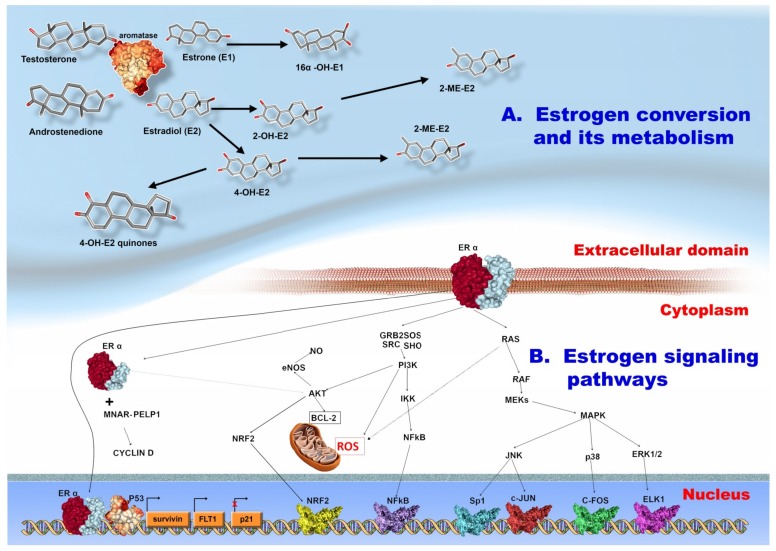Figure 2.
(A) Estrogen biogenesis, and its metabolism. The male hormones, androstenedione, and testosterone are converted by aromatase to estrone (E1) and estradiol (E2). Estrone is converted to 16α-hidroxy-estrone. The estradiol is converted to 2-hidroxy-estradiol (2-OH-E2) or to 4-hydroxy-estradiol (4-OH-E2). The 2-OH-E2 can be further metabolized to 2-methyl-estradiol. The 4-OH-E3 is also converted to 4-methyl-estradiol (4-ME-E2). The 4-OH-E2 can also interact with quinone, giving rise to the 4-hidroxy-quinones. (B) The signaling pathways initiated by estrogen interaction with its receptor. The ERα interaction with estrogen leads to the activation of several pathways. The RAS-RAF-MEK-MAPK pathway activates: JNK, p38, and ERK1/2 pathways. The JNK activates the Sp1, and c-JUN transcription factors. P38 leads to the activation of c-FOS and ERK1/2 to activation of ELK1. The estrogen receptor also interacts with GRB2/SOS/SRC/SHO, leading to the activation of PI3K-IKK, and the NFκB transcription factor. The PI3K activates AKT leading to the activation of the anti-apoptotic factor BCL-2, and the production of nitric oxide. The ERα can translocate to the cytoplasm or to the nucleus. In the cytoplasm, it interacts with MNAR-PELP1, and stimulates the activation of cyclin D. In the nucleus, ERα interacts with p53 and the DNA, leading to the up-regulation of survivin gene, Fms related tyrosine kinase 1-FLT1, and the down-regulation of p21. The 3D structure of proteins was taken from the RCSB-PDB database (https://www.rcsb.org/).

